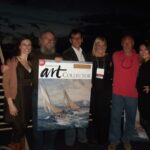Below are photos from Oil Painters of America’s Twenty-third Annual National Exhibition, which was held at The Bennington Center for the Arts in Bennington, Vermont.
To see all photos taken at the 2014 National Exhibition, click here.
National Show
How to Prepare a Winning Portfolio
Interview notes by Elizabeth Robbins
Artists eagerly poured into the lecture room to hear what Scott Eubanks (Gallery Russia), Scott Jones (Legacy Gallery), and Beth Lauterback (Scottsdale Fine Art Gallery) had to say about Portfolios and getting into galleries.
 In our modern age of new methods for presenting our paintings; this group of experts gave us a window into their world of submission expectations.
In our modern age of new methods for presenting our paintings; this group of experts gave us a window into their world of submission expectations.
Galleries are swamped with submissions, so artists, do your homework! Find out if the gallery that you desire to be in actually is a good fit for you and your work. For example: Legacy Gallery averages 248 submissions per month. Unfortunately, 95% of these submissions have no idea what kind of work Legacy Gallery sells. Match your subject matter, your pricing and your style to the kind of work that the gallery actually exhibits. Then, be a salesman, sell yourself to that gallery.
Be considerate of the gallery. Don’t walk into a gallery without an appointment and expect them to drop everything and look at your work. Use a portfolio to present your work. The type of portfolio doesn’t matter, digital or print portfolio, although all three of these galleries prefer e-mail portfolios. Whether you show a variety of subjects or just one, your portfolio of images is as good as the worst piece shown. Be sure to show only your best. Galleries are first looking for standout art, and secondly, your bio, good shows, publications in magazines, and competitions. Likewise, they are disappointed if only one piece is strong. They will be looking at your work to see if you consistently produce good quality art that sells. Need they remind you, they are in the business of selling paintings? Their wall space is valuable and they need to move art. It doesn’t matter if you can paint in all mediums and many subjects. In your portfolio, if you do offer them a single medium and a single focus, it is easier for them to see how your work will fit into the gallery. It will tell them if and how they can sell your work.
Be sure to check each gallery for their specific format for submission then stick to those guidelines. It is not about the packaging of the portfolio; it is all about informing the gallery of your best qualities, such as:
Education: Whom did you study with and with what program.
Web site: This gives your work a presence and links to the gallery. In no way should you work in competition with the gallery for sales. Your web site should work jointly with the gallery to create sales for you. Be a partner with your galleries, include links to their web sites.
Competitions: Only include the big shows, not the small shows (no county fair awards, please) and especially not the shows that you entered but were not accepted.
Publications: Articles are great, but not necessary if your work is strong. If you get an article or two, excellent, but in the meantime, put out press releases on your work and your awards.
Images of Paintings: Show only your best paintings with a variety of compositions that will exhibit your strong points.
Personal Rapport: Any gallery that is considering bringing you into their stable of artists needs to feel comfortable about working with you. Are you easy to work with, forward thinking, and creating your own opportunities in your career path? Don’t tell a gallery that you are better than “so and so”. That is not the way to approach a gallery.
Timing: Remember they reminded us, that timing is everything and lots of exposure helps the odds. Put yourself out there every way that you can, magazines, shows, awards, web sites, Facebook, Blog, etc. They will notice you. Show them your best painting. Catch their attention. Let them be the judge of what they can and cannot sell. They each have their own client base and know what will and won’t sell in their market.
Rejection: Okay, so you have been rejected from a gallery, pick your self up and try another one. You don’t want to be in a gallery that isn’t excited about your work.
Question : In the midst of this staggering economy, is this a good time to apply to galleries, or should artists wait until the economy strengthens?
Answer: Do it now. Many galleries are looking for fresh ideas to grab the patron’s eye and pocket book. This may be the time that galleries are replacing or adding new artists.
Question: Do you look at all the submissions?
Answer: Scott Jones, of Legacy gallery, says he looks at everyone’s submission and their websites. He looks for that magical quality that grabs him. Scott did admit that after 3 years of looking at the submissions for the Legacy gallery, only two submissions got into the gallery. This last comment created quite a stir in the audience. A wave of discouragement could be felt throughout the room. However, Scott reminded us that he and the other galleries are always looking at many sources for their artists. He has a list of 109 favorite artists that he is secretly watching and always looking for more artists to add to the list. He regularly checks out their web sites and links that those artists have to other artist’s web sites. That is how he finds other artists. It is easy for him to surf the web looking for new and exciting work. He loves Blogs, but not Blogs or websites that are not updates regularly. He watches artists mentioning other artists. It is a wonderful way to find new painters. Other recommendations: Newsletters: example – Clint Watson’s newsletter – one artist vouches for another. That goes a long way. Contests: i.e. win a Ray Mar Contest. Scott is a huge fan of OPA. It gives artists tremendous exposure. He asked 7 artists at the OPA show to be in Legacy Gallery.
Question: Typically how many paintings do the galleries want from artists coming into their gallery?
Answer: Scott Eubanks- six paintings to start off, four paintings to be hung and two more in the back. Beth Lauterbach answered, six paintings plus good photography of each painting. To create a good connection with her clients she also requires a good contemporary biography (don’t dig too deep into your past) and a good photo of the artist.
All three Galleries agreed:
- Do keep sending submissions to galleries
- Keep your web sites current. Only show your best work. Take off your older paintings.
- Enter shows. Win awards
- Get exposure from many sources: Magazines, Facebook, Blogs, Newsletters.
- Don’t get discouraged.
- Look for galleries compatible with your work.
- Persevere. Keep putting it out there
- Seek a gallery that is wild about your art, they need to fall in love with it.
- Seek a gallery that is run or owned by someone you can trust and is enjoyable.
One of the tough jobs being an artist is that you must find people that share your love of subject matter and style. You must be successful both at painting and also at finding those people that love what you paint.
In closing, for those artists already in galleries, these three galleries all had final words of wisdom!
Question: What if an artist is doing all of the above, but the public isn’t buying his/her paintings?
Answer: Here are some points that Scott Eubanks gave us to consider why art doesn’t sell (besides the poor economy):
- The painting is not as good as originally thought.
- It is over priced. What is the actual track record for that artist’s work.
- Same subject over and over
- Bad choice of subject matter.
- All the paintings from one artist look alike.
- Perhaps the gallery that your work is currently in, but not selling, is not helping you sell the art. Perhaps the gallery itself doesn’t have enough exposure.
- Work your craft, perfect your skills. Climb to new heights.
- Carefully consider your price and increases based on performance.
- Choose subject matter that appeals to the clients in your galleries.
- Find your uniqueness, build excitement in each painting.
- If your gallery isn’t a good fit and you are not selling, look for another gallery that is a good fit for your paintings and you.
- Don’t ever compete with your galleries, they are your business partners. Take good care of them.
- Connect your work to your galleries.
- Take your older paintings out of your current galleries and replace them with uplifting paintings. Scott Jones called them “Prozac Art”. There is enough stress in everyone’s lives, people are needing and buying peaceful, pretty art that soothes their minds and souls.
Most of all, Beth Lauterbach concluded, “What you do well, continue to do well. If you are selling, keep doing it”.
We all left the room inspired!
2013 National Exhibition Winner Spotlight
The OPA 2013 National Exhibition was an exciting event with a brilliant display of skill and oil painting mastery.
We’d like to introduce you to a few of our National Exhibition Winners. Meet Tom L. Nachreiner, winner of the Dorothy Driehaus Mellin Fellowship for Midwestern Artists; Shizhong Yan OPAM, winner of the Gold Medal Award for the Master Signature Division; and Johanna Harmon OPA, the Gold Medal Award winner in the OPA Associate/Signature division…
Tom L. Nachreiner
The Dorothy Driehaus Mellin Fellowship for Midwestern Artists

“I want to say just enough with paint to evoke the imagination.”
Tom paints for the love of dynamic composition, the celebration of color, and the tactile feel of applying juicy, wet paint to the canvas, at the same time having fun, enjoying the sounds and feelings of being outdoors, talking to others, doing what he loves, and trying to learn as much as he can before the end of each day.”
Tom is represented by Edgewood Orchard Galleries in Fish Creek WI, at Katie Gingrass Gallery in Milwaukee WI, and online at www.tomnachreiner.com
Shizhong Yan OPAM
Master Division: Gold Medal Award

In 1998, Shizhong and his family moved to the United States where he began a new chapter of his life as well as artistic career. Shizhong now resides in Illinois. He has four collections of artworks published and was published by countless magazines and newspapers. Shizhong has had many solo and group exhibitions in China, United States, Japan, France, Australia, Canada, Taiwan and Hong Kong. He has received many awards and his paintings are collected and loved by collectors all over the world. www.szyan.net
Johanna Harmon OPA
Associate/Signature Division: Gold Medal Award

Johanna Harmon OPA was born in 1968 in Milwaukee, Wisconsin, but spent most of her childhood in Tempe, Arizona. Johanna began designing and recording visual observations at the age of seven, but it wasn’t until almost two decades later that she was introduced to the traditional language of art at the Scottsdale Artists’ School in Scottsdale, Arizona, the Fechin Art Institute in Taos, NM, and the Art Students League of Denver in Denver, Colorado. There, she studied painting alongside prominent figure artists with varied artistic philosophies and approaches such as Carolyn Anderson, John Asaro, Scott Burdick, Mark Daily, Daniel Gerhartz, Quang Ho, and C.W. Mundy.
Her work has been exhibited with the Art Renewal Center, The Artist’s Magazine, California Art Club Gold Medal Exhibition, Oil Painters of America (OPA), Portrait Society of America, and Scottsdale Artists’ School. She has received numerous prestigious awards throughout the years. Most recently she was honored with the OPA Signature Member designation, and acceptance into the 2013 Oil Painters of America’s 22nd National Juried Exhibition— her eighth National Juried Exhibition— where she received her second Gold Medal Award, becoming the first artist to receive two OPA National Exhibition Gold Medal Awards in the organization’s history. Her first Gold Medal was awarded in 2007.
Over the past decade, her work has been presented in numerous solo, group and juried exhibitions, and is collected internationally. Her work has been published inSouthwest Art, Artbook of the New West, and Focus Santa Fe.
Harmon has taught workshops at North River Arts Society in Marshfield Hills, MA, and the Coppini Academy of Art in San Antonio, TX. Currently, she teaches at The Art Student’s League of Denver. Her emphasis is the clarification of visual intention, while nurturing the overall painted subject. This pivotal understanding defines her work today. She credits Cecilia Beaux, Nicolai Fechin, John Singer Sargent, Joaquin Sorolla and Anders Zorn as inspiration.
Johanna now resides in beautiful Highlands Ranch, Colorado, with her husband, Steven, of 16 years. www.johannaharmon.com
Painting Fred Red
 If you didn’t make it to the 22nd National Exhibition & Convention this month in Fredericksburg, TX, you missed a lot. It was better than ever. But don’t despair, just begin planning and saving for next year!
If you didn’t make it to the 22nd National Exhibition & Convention this month in Fredericksburg, TX, you missed a lot. It was better than ever. But don’t despair, just begin planning and saving for next year!
Events like these are reminders of who we are and who we want to be. This year, I met so many top artists for the first time — artists I had interviewed and written stories about but never met or whose artwork I had not seen in person. While you can read all the books, magazines or surf the net from dawn to dusk — each helpful and invigorating in their own ways — to be face-to-face with the art and the artist is like drawing a Royal Flush in a Vegas poker game!
The exhibition itself was superb, presenting an amazing array of talent, subject matter, and style. At any other show, we might expect to see a handful of paintings that knock our socks off, blow our hair back or electrify our senses—but the exhibition at Insight Gallery this year hit all those categories and more. Painting after painting revealed craftsmanship any professional artist would be proud to call their own; paintings that exemplified what can be achieved with hard work and dedication. Underscoring the impression the show made on me were the many red dots that caught my eye and told me that art lovers felt the same.
 Once the reception was over, the crowd gathered for another exciting awards ceremony—replete with surprises, awards and well-earned nods for the winners from their peers. It was time to celebrate and acknowledge the culmination of months of preparation by many of the finest artists in America. We wish every one of you who participated could have been there too.
Once the reception was over, the crowd gathered for another exciting awards ceremony—replete with surprises, awards and well-earned nods for the winners from their peers. It was time to celebrate and acknowledge the culmination of months of preparation by many of the finest artists in America. We wish every one of you who participated could have been there too.
By Sunday morning, Insight gallery owner Meredith Plesko told me that 40 paintings had already been sold. Checking in with her this past week, she informed me that the count is now well over 50 and has amassed nearly $200,000 in sales. Plesko was still awaiting several clients who had their sights on larger pieces, which leads her to believe that totals will undoubtedly rise even higher. The gallery loved hosting the OPA and, speaking on behalf of those who attended, all had a fantastic time!
Southwest Art magazine again put on their first-class opening event, the “Pampered Paint Out,” this year and Kimberly Moore whipped up an unforgettable day, including a continental breakfast, lunch and a wine and cheese send-off to help revive tired artists who painted the hours away.![]()
When Friday night rolled around, it was time to relax and enjoy a beautiful evening during American Art Collector magazine’s “Party Under the Stars, Texas Style.” Dining outside under a glorious old oak tree at the historic Pat’s Dance Hall, guests spent the night sampling some of the best barbeque in Texas and listening to one of Austin’s hottest up-and-coming country bands, “The Lonesome Heroes Band.” It was a perfect end to a perfect day. Thanks to Joshua Rose, Amy Gause and Alex McKee for putting together such a memorable event for OPA members!
 However, competing and sharing with colleagues, as well as the wonderful opportunity to network and party with vendors and new friends, is only a part of the convention’s value. There were demos by such masters as Sherrie McGraw (this year’s judge of awards), Kenn Backhaus, Scott Burdick, John Michael Carter, John Cosby, and Elizabeth Robbins. We all learn from watching those who wield a skillful brush and, this year more than ever, we came away inspired. I think what impressed me most about the demonstrations were how generous and kind each artist was as they shared their insights and answered questions. There were no showboats, no posturing—only stars within our tribe bent on helping us all move forward. They appeared so at ease. They were in their natural element and among friends.
However, competing and sharing with colleagues, as well as the wonderful opportunity to network and party with vendors and new friends, is only a part of the convention’s value. There were demos by such masters as Sherrie McGraw (this year’s judge of awards), Kenn Backhaus, Scott Burdick, John Michael Carter, John Cosby, and Elizabeth Robbins. We all learn from watching those who wield a skillful brush and, this year more than ever, we came away inspired. I think what impressed me most about the demonstrations were how generous and kind each artist was as they shared their insights and answered questions. There were no showboats, no posturing—only stars within our tribe bent on helping us all move forward. They appeared so at ease. They were in their natural element and among friends.
Friday, Saturday and Sunday each brought presentations touching on various aspects of a professional artists’ life. Each speaker contributed insights to our understanding of all that this crazy business requires.

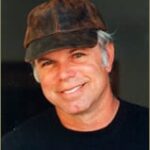
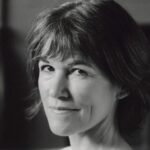

One of my favorite presentation events was Southwest Art’s editor-in-chief Kristin Hoerth’s interview with Sherrie McGraw on Sunday morning. Hoerth delved into McGraw’s life and influences, and the artist responded with warmth and wit and practical advice. To achieve what McGraw has achieved and to see the quality of her craftsmanship reminds us all that hard work and determination pay off. Now and then we see an artist attain a flash of popularity only to fade from view shortly thereafter. But the real masters lay down a solid foundation and then add to it brick by brick, year by year, challenging themselves, extending a hand to others, and remaining open to life and art. Sherrie is truly one of those.

As we prepared to say our goodbyes, we had a last reminder of the practical side of art as a profession. Bill Bush, owner of Frederickburg Artists’ School and a certified public accountant, shared his thirty years of experience dealing with such issues as taxes, insurance, agent relationships, gallery representation, and the finer points of “doing business.” We left fully charged!
This was a long post, but for those who couldn’t be with us in Fredericksburg, I wanted to share how rich the national exhibition and convention experience can be. I wanted to urge you now to begin planning for next year’s so you can take it all in for yourself. You won’t be sorry.
For those who were there, you each did your part. You painted Fred RED—and they won’t soon forget you!
Party Hearty! For the Fourth Year, American Art Collector Sponsors a Great Shindig!
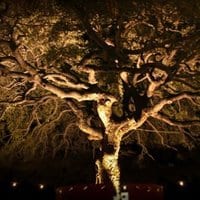
Friday night at the OPA national exhibition, American Art Collector (AAC) magazine will throw a party to be remembered. This year’s will take up Texas flavor and go all out—great food and music under the stars at Pat’s Hall, a historic Texas dancehall, surrounded by some of the most talented artists in the country. What more could you ask for?
As is always the case, the staff of AAC puts a lot of thought into producing their signature event, and this year is no exception. Editor Joshua Rose gives us the inside scoop:
On an earlier visit to Fredericksburg, we discovered a local BBQ joint called Cranky Franks. We immediately fell in love with their pulled pork and BBQ’d chicken and have eaten there on every subsequent trip. When we found out that this year’s party would be in Fred, there was no question who we’d have cater it.
And on a trip to Santa Fe, we met The Lonesome Heroes, an Austin-based country-western duo. They are wonderful singers, songwriters, and performers, and we all became friends quickly. We are very excited that they’ve agreed to come down from Austin to play for our party!
Imagine this—sitting on picnic benches under a giant, historic oak, drinking lemonade, eating some of the best BBQ you’ll ever taste and listening to the beautiful songs of one of Texas’s best country-western duos. We can’t think of a better way to spend a night in Fredericksburg, Texas.
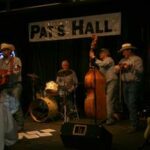
Amy Elliott Gause, AAC’s sales and marketing director, is equally excited about this year’s event: “We couldn’t have found a better place to host our annual party at the OPA National Exhibition. This just might be our best yet—and we are currently arranging for the group of elk who showed up last year to make a special appearance this year as well!”
All I can say is YUM—great BBQ and music under that vast Texas sky, good-looking cowboys, sexy cowgirls, terrific sponsors, and hundreds of creative friends who love to talk about art. My kind of fun—
As the song goes, “The stars at night are big and bright, deep in the heart of Texas—” See you under the oak tree!
View some photos from last year’s American Art Collector’s party


